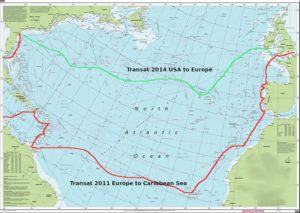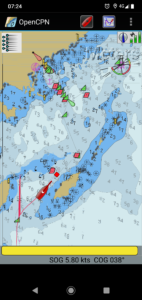Welcome to Kelsall 39 sailing. Keep scrolling for the latest blog posts. Here in the beginning i have the frequently asked questions and answers! Common questions and answers:
- Firstly, what to pack? If going for a sailing trip it can be difficult to know what to bring! Actually there is a post here on the site where I talk about this. You can read about what to pack here.
- Secondly there is always the question of expenses. How much does it cost per day? This answer depends a little bit on which area which we are sailing. Eastern Europe is cheaper than England for example, and because we share all the food and marina/harbour costs that makes a difference for the daily cost per crew. To keep the long story short, what we do is that I keep a very careful note of every expense. Then as different people come and go we re-set the counter and share the costs of food, marinas, and fuel for engine (hopefully we don’t use it) and that’s about it. I really don’t think that I have been anywhere where daily costs go above 20 euro per day, but I think it is safest to calculate about 15.
- Thirdly, do you need to have experience? This question is also a very common one. I always try to explain that it does not matter if you have sailing experience or not. We organise the watches so that people of different experiences are together. The idea is to help each other and make sure that everyone is comfortable. If anything seems strange, or needs doing, then I am always close by.
Thanks for reading, and hope you enjoy the blog posts here on the website!
- Galicia to Bretagne – Sailing North Across the Bay of Biscayby Kai
We left from Ria de Arosa on Thursday evening, from our anchorage not far from the town of Boiro. Four days in Galicia waiting for a favourable weather window to cross the Bay of Biscay and sail to Brittany. Four really nice days, and what can be said is that four days was not enough, and we will have to go back soon again!
What we had as a weather window has made for a good trip. The winds for the first two days were light and from the North, but generally allowed us to make distance West and a little North at around 310°. This we did to a point about 125nm Northwest of Capo de Finisterre, taking advantage of wind shifts to go on port or starboard tack, but generally always sailing on starboard. The light upwind, and long kind swell meant we could go by self-steering and no helming! Great news as the boat lacks an autopilot. Two beautiful calm sunny days, such a pleasant way to pass the time!
Then, with the arrival of the clouds and humidity we had the Westerly airflow descend to our latitude, and the remaining 350 miles to Brittany have been sailed taking advantage of these winds. The weather is a little grey, sometimes a little foggy, sometimes raining a little, occasional sun peeking through the clouds, or a glimpse of the starry night sky and final crescent of the moon.
The strategy for the Biscay crossing is as usual with this; keep West until you know you’re on a home run, and it has worked well for us. When we did get the stronger breeze, our point of sail has been with the wind aft of the beam and thus the boat has been running with the waves, and offering plenty of opportunities for catching a surf! We have only made 13 knots as a top-speed, but consistent good speed meant we have also clocked a 24 hour run of 180 miles, which is pretty nice going.
Our port of arrival was Île de Sain, as it was a too late in the day to make the last 15 miles to Douarnenez. A night sleeping and not keeping watches, then on the morning tide try and make Douarnenez and find a place for the trimaran in the harbour there! I do know that they have locks sufficiently wide for us, as I’ve been past there on bicycle and asked them.
Fantastic, now the Brittany adventures await, and we are very happy to be here!
550nm (shortest distance: 400nm) sailed in 98h; average speed 5.6kt; max speed 12.8kt; and best 24h run 180nm.
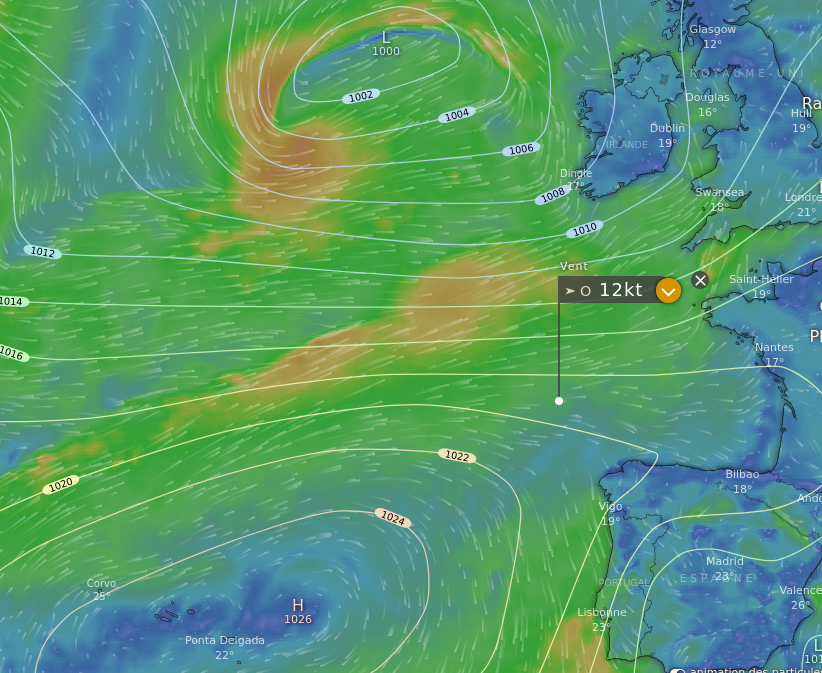
Weather systems for the Bay of Biscay 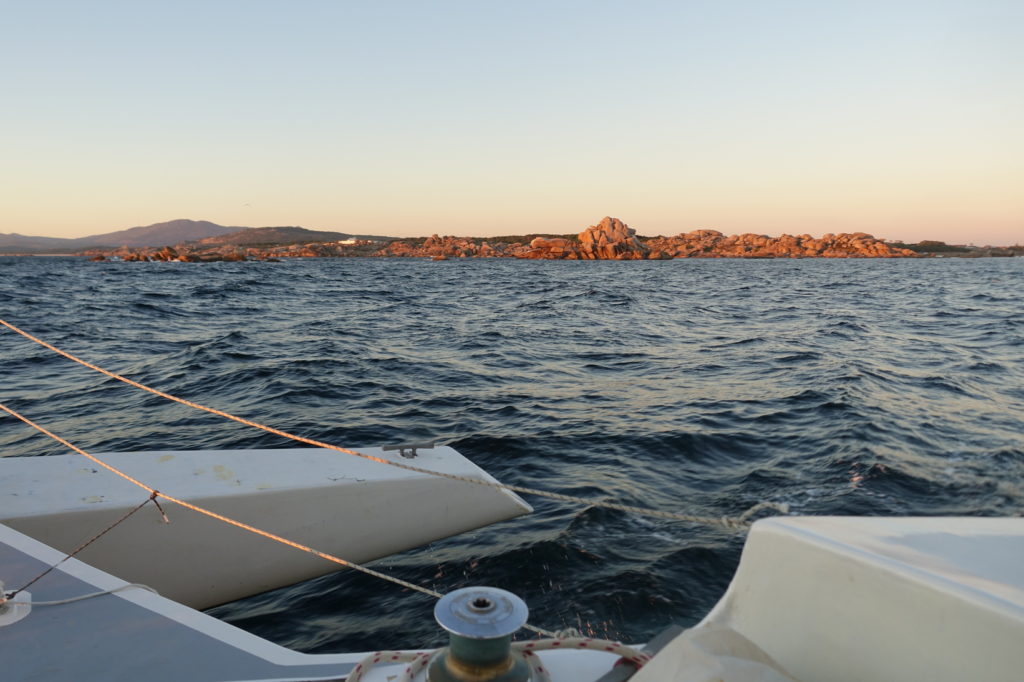
Departure at Sunset from Ria de Arosa - Ria de Arosa and Baiona of Galiciaby Kai
It was four nights total we were in Galicia, and it’s been lovely! It is one of those places I really would like to return to and see more of. The weather is of course know for being windy and cold… like all the Celtic Nations regions I suppose. But there is such charm in the areas where the sea is so present in the land.
We were expecting a tourist heaven, and lots of people… but generally we saw only Galicians, and some Spanish tourists. No German, French or English. August is high season, so I’d say that when the coast of Brittany is going crazy with visitors, and Portugal also, during the months of June, July and August, then Galicia has to be one of the best places to hang out. I really think Galicia is one of the best areas to visit by boat on the Atlantic coast of Europe.
The first stop for two nights was Baiona, near Vigo. This is quite a big city, and we had a day to check it out. It’s an interesting mix of old and new, and there are traces of the different eras of the city everywhere. A cement factory is mixed in with what now is residential areas. It seems building new is more in line with the economy than tearing down the old and disused.
We had some luck with the events happening during our visit. They had a downhill mountain biking event in the city for example. Seems pretty dangerous to be going at those speeds surrounded by concrete and stone walls everywhere! Also, they had BMX championships and other associated events such as break dancing etc. Great performance by everyone, and it was a hot day too!
After the anchorage at Baiona we sailed the 25 miles to Ria de Arosa, the third Ria counting from the South. There we spent one day walking the entire length of the North coast of the Ria de Arosa, about 22 kilometres in total. The coastline is a mix of small river-mouths, towns and harbours, but mostly beaches and rocky outcroppings, very similar to those found in Brittany.
We have made friends, learnt about the local fishing and some of what they do for food grown locally. We talked about income, the problem of illegal shellfish fishing, and about the rainy weather they get a lot of the year!
However, going back to the topic of food; a lot of food is grown in the areas around the towns, or even in town if the garden space allows. Main crops are maize, brussels-sprouts, tomatoes and pumpkins. There are orange groves, and lemon trees, lots of wall-nut trees and chestnut, avocado, apricot and plums. Apple and pear are found everywhere too, and of course almond trees too. It seems to be a fantastic place to grow fruit and vegetables!
Then there is the ocean, right next door… with all the delicious food which can be found there, besides the trawling and long-lining tuna fishing, they do a lot of shellfish and octopus catching, and farming a particular type of shellfish is also done extensively.
Galicia is a peaceful place, and I think from our short stop I am already concluding that the people who live there are open and helpful, as well as friendly with visitors.
The region is suffering similar issues as other rural parts of Europe. An ageing population, a very high dependence on the car, and failing public transport. Work is not well paid, and housing costs are high, both renting and buying.
It’s quite extraordinary how many abandoned and for sale buildings there are when you start to look about. Whole villages have been emptied in the last 50 years or so. It’s a development which has taken place in most of Weastern Europe, but here it still seems to be a little more recent that people have left the countryside.
Another thing, eating out and going for drinks, a topic of utmost importance!It’s rare to find nowadays in Spain, but if you buy a pint of beer you get a tapas included, and the prices, well, it’s €2.50 for a pint. The Tapas we had were Mexillones, a shellfish; the one they farm. Most places a plate like would probably have cost more than €10.00 alone. Service is fantastic, and tips are not a foregone conclusion. I have to say that it is a real pleasure going out for the evening for food. I would imagine though, that in wintertime the places which are open for business would be many fewer.
So, for next time visiting Galicia the plan would have to include exploring inland between Ria de Arosa and Ria de Muros. Apparently that peninsula is historically very important, and was a major site for the Vikings. I guess the Vikings saw little challenge in crossing the Bay of Biscay! Indeed, there is a lot more to learn about the region.
I’d also like to go up the Rio Ulla, and see the beaches and salt-ponds around Isla de Arosa… but in all honesty – there is just so much to see around the region! Fantastic hiking (it’s the region for the Camino de Santiago de Compostella after all), and endless coves and anchorages and rivers to explore by boat.
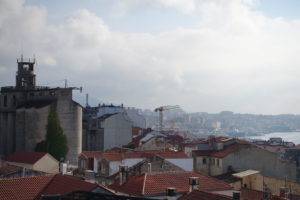
Vigo 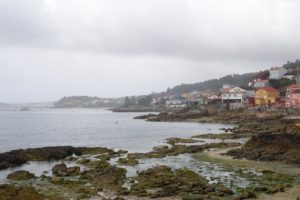
Ria de Arosa township 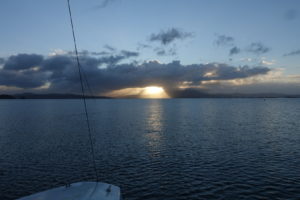
Sunrise 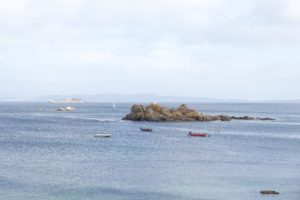
Rocky outcrops in Galicia 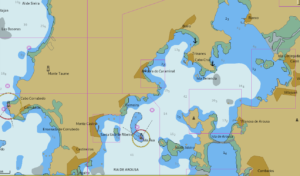
Ria de Arosa chart 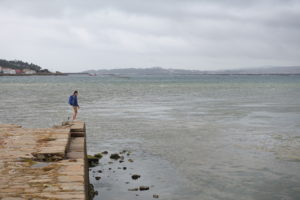
Beaches of shellfish 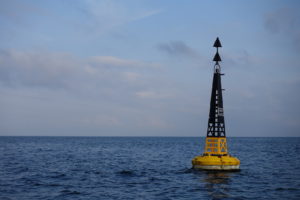
North cardinal marker 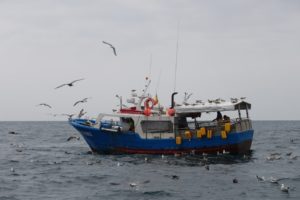
Galician fishing boat 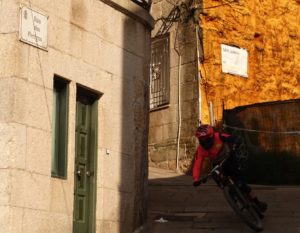
Downhill MTB in Vigo 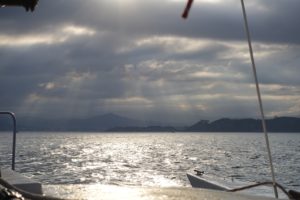
Approaches to Baiona in the morning - Cascais to Vigoby Kai
As the weather looked good on Wednesday 10th we sailed at mid-day from Cascais, with the idea in mind of perhaps going al the way up to Cabo Finisterre in Galicia, and then in one shot have a weather window to cross over to Brittany in Northern France.
I would have to say that we have had more or less the wind which was forecast, and as I was fearing, we are too late arriving at Cabo Finisterre and making a dash for Brittany. What the weather is saying is that strong Northerly winds in the region will generate big swell from the North, and quite soon our route across the Bay of Biscay will be blocked by these Northerly winds as they move East in to the bay from the Atlantic.
The plan is now thus to make a stop here in Galicia, and then go for the passage to France in 4 days time, after the bad weather has passed. The time we have here will be for exploring one or two of the famous Rias of Galicia, and perhaps even ticking off a spot of work or two from the job-list for the boat!
Also, we are actually looking for more crew to join for the passage to France, so I’m hoping that somebody has a chance to travel all the way out here and join the boat sometime next week!
Anyway, the sail up from Cascais and Lisbon to here has been nice. A lot of time has been spent drifting. Four nights where we have mostly not even had to bother with sails. This makes for good rest and plenty of time for cooking nice food, reading, or going for a swim.
The days are usually with a little more wind, and we had one full day of down wind under spinnaker, a lovely smooth ride with fantastic steady speed. A real joy.
We’ve not had as many dolphin with us as on the sail from Algarve to Cascais. But what we have had was a fin-whale come by and check us out… and, what a sound they make when they breath!
Fortunately, also, we have seen nothing of the infamous Orca which move along this coast. There have been many yachts attacked… well, “played with”, by these Orca. One yacht was even sunk two weeks ago outside Sines in Southern Portugal.
We are now in the Ria of the Rio Vigo, and will stay the night at anchor by Bayone. visit the town and see what can be found here at this place! We are in Spain now, so a whole different thing than Portugal.
Departure looks to be on Thursday 18th, and we will also go to Ria de Arosa, which is some miles North from here.
Sailed 270nm in 94h, 1h engine. Avg. speed 2.88kts.
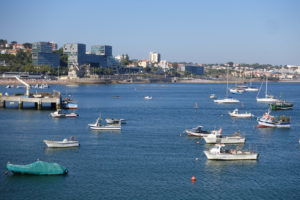
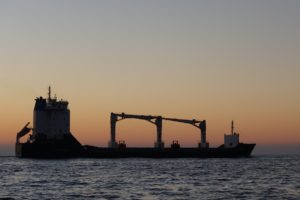
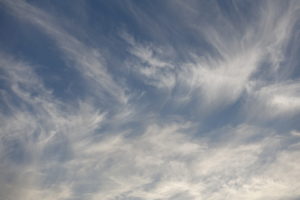
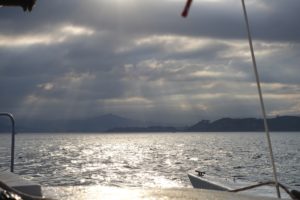
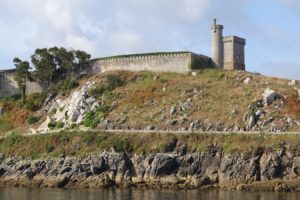
- Algarve to Lisbonby Kai
First leg on the long route North to Sweden is underway. The warm and sunny Algarve we have left behind, and now we are heading up the North Atlantic, and I’m writing this blog from here on the boat while at sea, I would say sailing, but we are now in fact drifting!
Departure was Saturday afternoon from Lagos, and we straight away had a good wind on the beam and nice sailing. It’s noticeable that as you get to Sagres and the South-western end of Portugal the weather get cooler, the sun is the same sun, and shines hot – but the air is that little bit less hot, and also a bit more damp. Overcast skies, like we have now – that’s rare in Algarve in the summer!
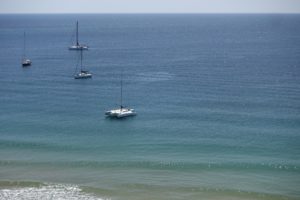
Anchorage at Sagres It’s actually a little bit difficult for me to leave the Algarve. Life here is very good I find. The thought of heading up into the rainy cold and windy North is not so appealing. I have to tell myself, and actually it’s true, the sailing, and the mornings and days up there are also beautiful. It’s not at all as bad as it seems!
There have been busy times here getting the boat ready for the sail North. A lot of work is about finishing up the new deck-paint job. Also, cleaning the hulls and getting them slick and efficient again has been a big job. We dried out on the beach at Ferragudo to paint the keels with new antifouling.
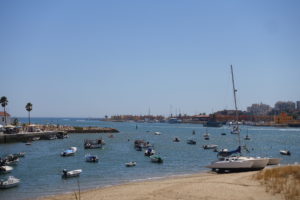
Quick work on low tide at Ferragudo Anyway, after Sagres we have Cabo de Sao Vicente which was in our sunset view the first evening. It is then some 100 miles up to Cascais, West of Lisbon. After that first afternoon and until midnight the first night the sailing… it has been extremely slow. We had sunrise also with the view of Cabo de Sao Vicent. In very light conditions yesterday afternoon until about mid-night as well sailing was lovely. Sitting at 3 to 4 knots with the boat taking care of the direction herself. The mornings we have been drifting and watching other yachts motor on by at their mechanically powered 5 to 6 knots. Nothing to get upset about, it’s just we way it works…. But the fact is that we are now 2PM on Monday, and with an engine we would have easily arrived yesterday evening.
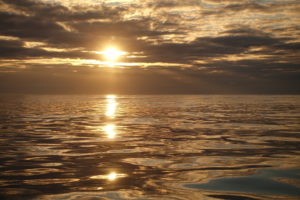
Sunset calms and a glassy ocean On the good side is that life onboard is comfortable even when drifting. This boat is not nearly as roly and uncomfortable as a monohull when there is no wind. Another good point is that we have seen so much wildlife. When it’s peaceful and quiet you can hear a whale breeching, you hear the dolphin as they approach. It’s so much easier to notice things around you when not hurrying along to a destination all the time.
We are now just outside Cascais, West of Lisbon. This is where we stop to make a crew-change and get more supplies on board, as it looks like perhaps, with a bit of luck we can make the trip to Brittany in one shot from Lisbon.
Trip details: 180nm sailed in 68 hours – average speed 2.65 knots.

